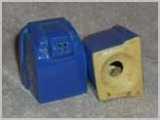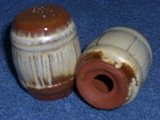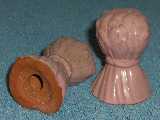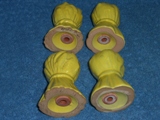


Shock of Wheat Shakers #48H: 1951-1957 & 1981-1983
Frankoma did many designs to honor the state of Oklahoma and the prairie environment. The Shock of Wheat shaker is one of them. This is a very functional design, a product of the post-war era. The shaker grips easily in the hand and the condiments flow freely.
Frankoma produced this design twice, once in the fifties and once in the eighties. The shakers produced from 1951 to 1957 are mostly Ada clay with some made on brick red Sapulpa clay. Of the ones produced on brick red clay the rutile glazes were made with American rutile and the contrast and glaze coloring is outstanding. The bottom of these early issues will be entirely unglazed regardless of the clay used.
The shakers produced from 1981-1983 are all produced on the pink clay of the era. The rutile issues were made with Australian rutile and the results are typically washed out. The glaze-to-clay contrast is low and the glaze colors are bland. The concave part of the base of these later issues will be glazed. For the novice it is sometimes easy to confuse the later light pink clay with over-fired Ada clay. If, however, one watches for the bottom glazing on the 1981-1983 issues, the confusion is easily avoided.
The original design of this set has the dispensing holes in a straight line, four for the salt and three for the pepper. The available literature tells us that in the re-issue design, as an aid to the collector, Joniece Frank changed the dispensing holes to the shape of an “S” and “P” for easy identification of the newer sets. Close observation tells us, however, that many of the “re-issues” have the straight line dispensing holes. I believe this factual error was first printed by Phyllis and Tom Bess.* Others simply accepted the Bess version and reprinted it.
The re-issue design of the 1980's is in fact about evenly divided between straight line and cursive S/P hole sets. Collectors should have little trouble with this except on straight line hole set examples where Frankoma failed to glaze the base, a fairly frequent occurence. The collector is left to decide the production period based on glaze and clay colors.
I divide these shakers into four groups as follows:
Type 1-Ada: The early Ada clay shakers with the straight line hole set.
Type 1-Red: The early red clay shakers with the straight line hole set.
Type 2-SL: The re-issue pink clay shakers with the straight line hole set.
Type 2-SP: The re-issue pink clay shakers with the double diamond S/P hole set.
Despite only eight years of production the collector will find wheat shocks in a wide range of glaze colors. This design is fairly easy to damage by chipping the sharp edges of the base.
*Frankoma Treasures, Phyllis and Tom Bess, p. 126.



















